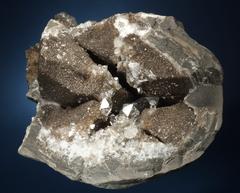last modified: Thursday, 11-Sep-2014 19:33:37 CEST
In many areas all over the world the quartz crystals found locally have been named "diamonds". The nomenclature goes like:
"[Some_location] Diamonds"
of course in any language you choose.
The term "diamonds" usually refers to small individual idiomorphic and double terminated translucent to transparent quartz crystals. With the exception of "Saxonian Diamond" and "Matura Diamond" (both topaz) I'm not aware of a similar use of the term "diamonds" for any other mineral, not counting the many famous jewels that have been mistaken for diamonds.
Quartz "diamonds" are found at many places all over the world, just to name a few (and this is definitely an incomplete selection):
It needs a good deal of imagination to see diamonds in some of them. The ones most off in terms of crystal form are probably "Lake County Diamonds", and they do hardly resemble ordinary quartz.
Perhaps the ones most off in terms of luster are "Stolberger Diamanten": when looking for them it took me quite a while to realize that they were even laying around on the path I was walking on.
Judged from what I've seen so far (not to much, though), "Herkimer Diamonds" seem to be the most sparkling. In that respect they outperform almost every other piece in my collection. I bet if you dumped real diamonds and Herkimers in a pit, most people would pick the Herkimers and leave the real ones.
Note: I should mention that "Herkimer" is not a trademarked name and very often you will see offers of similar material from other places, e.g. China.
Schaumburger Diamanten, Germany
"Schaumburger Diamanten" are found in drusy pockets in marl limestone at a classical location in the old County (in German: "Grafschaft") of Schaumburg, about 60 km WSW of Hannover.There are usually 2 generations of quartz crystals in the concretions, one lining up as clear rock crystals on the walls of the pockets along with calcite, and a later one forming double terminated crystals or scepters on top of the first generations crystals. Often the second generations are true smoky quartz (colored by radiation, and not by e.g. organic impurities). As both the first and the second generation of quartz crystals have been subject to the same radiation, the second generation must have developed in a solution that contained sufficient amounts of aluminum to be built into the crystal lattice (see the smoky quartz section at macrocrystalline varieties for more on this).
Some purists will say that only the clear and colorless scepters are to be called "Schaumburger Diamant", but the name is frequently used in a wider sense.
Erhard Zimmermann runs a web page dedicated to Schaumburg diamonds, www.schaumburger-diamant.de, and has put has many pictures online.
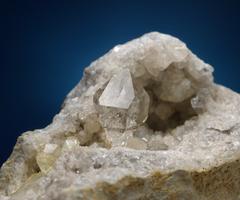
10mm 1200x1000 130kb - 2400x2000 383kb |

5mm 900x916 69kb - 1800x1832 203kb |
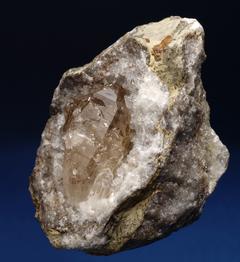
20mm 1024x1151 179kb 1718x1878 426kb |
Two things are remarkable about Schaumburg diamonds:
1. It is rather uncommon to find smoky quartz in sedimentary rocks, as they usually lack radioactive elements that are the source of high energy radiation. Some authors suggest that cosmic radiation might be the cause of the coloration (but see the discussion of this at "smoky quartz").
2. There is usually just one scepter in each of the smaller pockets, and just a few in large ones, while there are often dozens of well crystallized "ordinary" rock crystals in the same pocket. It is strange that not most of the rock crystals developed scepters, as you can find it at many other locations.
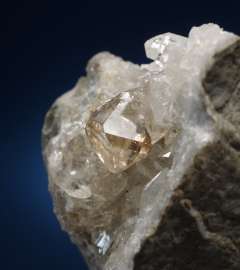
10mm 1024x1119 99kb |
Stolberger Diamanten, Germany

5mm 800x880 83kb |
The image shows a typical small double terminated hexagonal crystal in rhyolite matrix. Its diameter is 6 mm, but crystals more than 1 cm size do occur. It is translucent and has very little luster. The m faces of the hexagonal prism are usually very small or completely absent, but some crystals do show well developed prisms and look almost like ordinary, albeit dull rock crystals.
Diamant de Mirabeau, France

20mm 1200x849 192kb - 2838x2009 801kb
|
They occur in septarias in an Jurassic limestones and marls. The dealer I bought the specimen on the pics from told me they were once dug up during an oil prospecting drill in the 1970s, and have not been "mined" since. Similar finds have recently been made near Sisteron.
Sometimes you see references to "Drôme Diamonds" as being a synonym of Mirabeau diamonds. I have some doubts about this, as the Drôme area is more famous for its "Diamants Noir" than for the Mirabeau diamond - and the Diamants Noir are actually truffles.
The pictures to the right both show the same specimen, in the second picture I've turned the specimen a bit clockwise so the septarian structure can be seen more clearly.
More specimen of that locality are presented on the page Occurrence.
Diamanti di Carrara, Italy
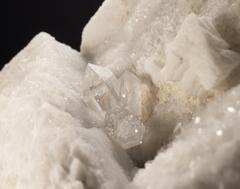
10mm 1024x808 79kb - 2276x1797 322kb |
Carrara diamonds are usually small, but crystals up to 18 cm have been reported. It is very difficult to find them, as pockets in the marble are rare, there are no obvious signs as to where to look for pockets, and the crystals are very difficult to spot in the white marble, so the prizes for specimen are often quite high. While Herkimer Diamonds, for example, have a typical habit and only show certain combinations of crystal faces, Diamanti di Cararra show much more varied forms and habits. Double terminated single crystals are not uncommon, but one can also find elongated crystals attached to the matrix at one end. Accessorial crystal faces (like the x- and s-faces, but also steep rhombohedra) are common, and more than 30 different crystallographic forms have been identified. The crystals are exceptionally clear and well-formed and apparently never bear any inclusions. The reason for their clarity is the very low silica content of the Carrara marble, with less than 0.1% SiO2 content, causing a very slow growth of the crystals.
Both pictures to the right are from the same specimen. They show a group of crystals, but single double terminated crystals can also be found. In the second picture one can see how clear the crystals are, the marble's surface structure can be viewed through the upper right rhombohedral crystal face.
Taking pictures of the specimen was a bit difficult, like shooting glass before a white wall. Should you ever plan to go to Carrara to find one yourself, don't forget your sunglasses!
Herkimer Diamonds, New York, U.S.A
Those deserve their own page.
Lake County Diamonds, California, U.S.A.
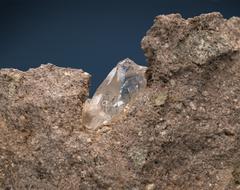
5mm 1856x1468 689kb |
The "crystals" sit inside young rhyolitic rocks (the area around Clear Lake is a young caldera) that readily weathers and decomposes, so the crystals can simply be picked up from the ground.
They are colorless and clear, and I've met a couple that had collected a handful of them for lapidary works.
I have no clue why these "crystals" are clear yet have not developed any crystal faces. Their conchoidal surface structure does not match the grainy structure of the surrounding rock, so it's unlikely they have formed syngenetically while the rock solidified.
I might be completely wrong and have to dig out some more information on this.
 Printer Friendly Version
Printer Friendly VersionCopyright © 2005-2014, A.C. A k h a v a n
Impressum - Source: http://www.quartzpage.de/dia_text.html

